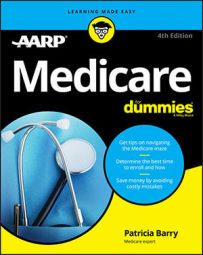 © Vitalii Vodolazskyi
© Vitalii VodolazskyiBesides that, however, is the simple fact that making sense of Medicare is difficult unless you understand what Parts A, B, C, and D actually mean.
Part A
Medicare Part A is usually described as hospital insurance — a term originally coined to distinguish it from medical insurance (Part B). But the phrase is misleading. “Hospital insurance” sounds as though Part A covers your entire bill if you’re admitted to a hospital, but it doesn’t work that way. The services you receive from doctors, surgeons, or anesthetists while you’re in the hospital are billed separately and are covered under Part B. And you don’t even have to be hospitalized to get services under Part A, because some are provided in settings outside the hospital or even in your own home.A more accurate way to think of Part A is as coverage primarily for nursing care. It helps pay for the following:
- The services of professional nurses when you’re admitted to a hospital or a skilled nursing facility (such as a nursing home or rehab center) for short-term stays or when you qualify for home health services or hospice care in your own home
- A semiprivate room in the hospital or nursing facility
- All meals provided directly by the hospital or nursing facility
- Other services provided directly by the hospital or nursing facility, including lab tests, prescription drugs, medical appliances and supplies, and rehabilitation therapy
- All services provided by a home health agency if you qualify for continuing care at home
- All services provided by a hospice program if you choose to stop treatment for a terminal illness
But, of course, Part A services themselves aren’t free. You still pay deductibles and co-payments for specific services.
Part B
Many people in Medicare never need to go into the hospital, but almost everybody sees a doctor or needs diagnostic screenings and lab tests sooner or later. That’s where Part B — known as medical insurance — comes in. The wide range of services it covers includes the following:
- Approved medical and surgical services from any doctor who accepts Medicare patients, whether those services are provided in a doctor’s office, in a hospital, in a long-term-care facility, or at home
- Diagnostic and lab tests done outside hospitals and nursing facilities
- Preventive services such as flu shots, mammograms, screenings for depression and diabetes, and so on, many of which are free
- Some medical equipment and supplies (for example, wheelchairs, walkers, oxygen, diabetic supplies, and units of blood)
- Some outpatient hospital treatment received in an emergency room, clinic, or ambulatory surgical unit
- Some inpatient care in cases where patients are placed under observation in the hospital instead of being formally admitted
- Inpatient prescription drugs given in a hospital or doctor’s office, usually by injection (such as chemotherapy drugs for cancer)
- Some coverage for physical, occupational, and speech therapies
- Outpatient mental health care
- Second opinions for non-emergency surgery in some circumstances
- Approved home health services not covered by Part A
- Ambulance or air rescue service in circumstances where any other kind of transportation would endanger the patient’s health
- Free counseling to help curb obesity, smoking, or alcohol abuse
You also pay a share of the cost of most Part B services. In traditional Medicare, this amount is almost always 20 percent of the Medicare-approved cost. Medicare Advantage health plans charge different amounts — usually flat dollar co-pays for each service.
Part C
The coverage provided by Part A and Part B together form what is known as traditional or original Medicare — so named because that was the extent of the program’s coverage when it began back in 1966. It’s also called fee-for-service Medicare because each provider — whether it’s a doctor, hospital, laboratory, medical equipment supplier, or whatever — is paid a fee for each service.But these days Medicare also offers an alternative to the traditional program: a range of health plans that mainly provide managed care through health maintenance organizations (HMOs) or preferred provider organizations (PPOs). These plans are run by private insurance companies, which decide each year whether to stay in the program. Medicare pays each plan a fixed fee for everyone who joins that plan, regardless of how much or little health care a person actually uses. This health plan program is called Medicare Advantage or Medicare Part C.
Medicare Advantage plans must, by law, cover exactly the same services under Part A and Part B as traditional Medicare does. (So, if you need a knee replacement, for example, the procedure is covered — regardless of whether you’re enrolled in a Medicare Advantage plan or in the traditional program.) But the plans may also offer extra benefits that traditional Medicare doesn’t cover — such as routine vision, hearing, and dental care. Most plans include Part D prescription drug coverage as part of their benefits package.
Still, being enrolled in one of these plans is a very different experience from using the traditional Medicare program. Your out-of-pocket costs are different, and so are your choices of doctors and other providers.Part D
Part D is insurance for outpatient prescription drugs — meaning medications you take yourself instead of having them administered in a hospital or doctor’s office. Medicare’s drug benefit was only added to the program in 2006, a full 40 years after Medicare began. Since then, it has saved huge amounts of money for millions of people and allowed many to get the meds they need for the first time.Part D is a complicated benefit that takes a lot of getting used to. Here are just some of the peculiar ways it differs from other drug coverage you may have used in the past:
- Coverage goes through four distinct phases during a calendar year, and in each phase the same drug can cost a different amount.
- To get coverage, you must select just one private plan that provides Part D drugs out of many plans (at least 15) that are available to you.
- Different plans cover different sets of drugs, and no plan covers all drugs.
- Plans set their own co-pays for each drug, and these amounts can vary enormously, even for the same drug.
- Plans may require you or your doctor to ask permission before they cover certain drugs or to try a less-expensive version before they cover the one you were prescribed.
- Plans are allowed to change their costs and benefits or to withdraw from Medicare entirely each calendar year.

